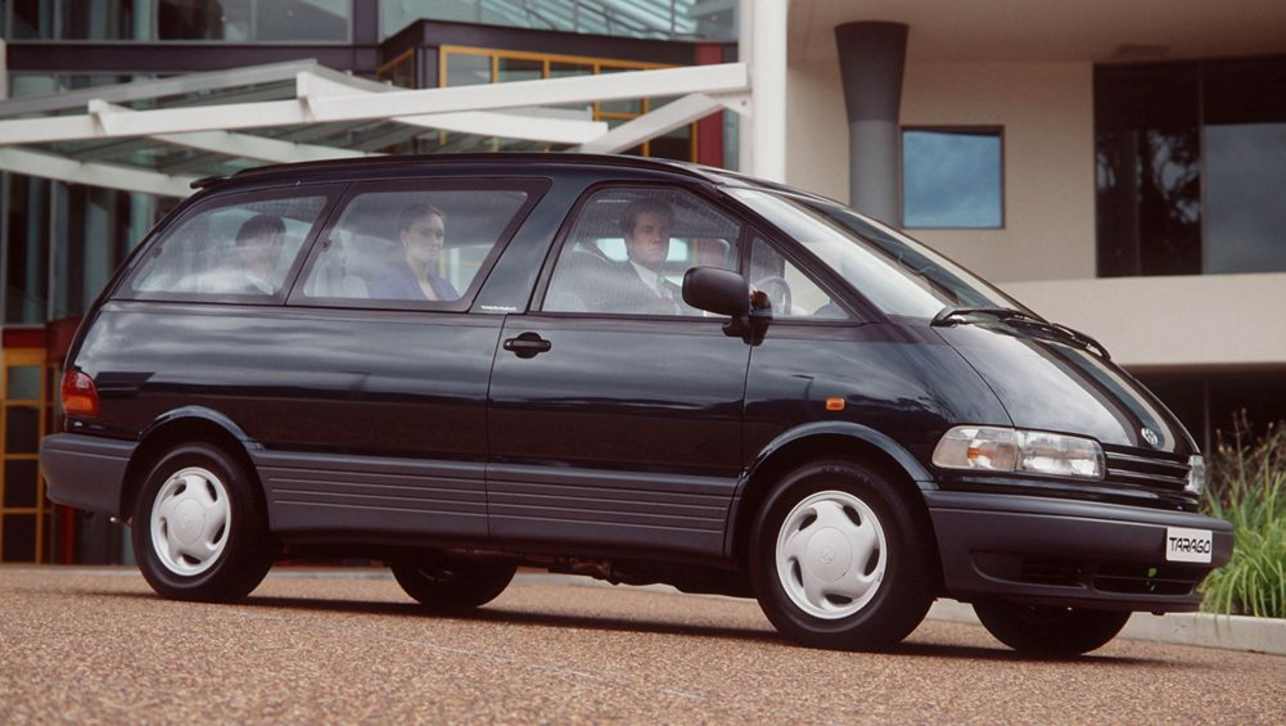Volkswagen has just ripped the covers from its retro-referencing ID Buzz people mover and van.
The spunky all-electric bus is a modern take on the iconic Kombi (or Transporter, or Bulli, depending on where you’re from) that made its debut in 1950.
Volkswagen isn’t the only brand referencing its past in a modern design. The upcoming Nissan Z coupe borrows cues from the 240Z of the 1970s at the front and the sleek 300Z of the 1990s at the rear.
It’s fair to say we will see a lot more brands reconnecting with their past via design, especially in the era of electric mobility.
Without further ado, here are our picks for cars that are the perfect candidates for a retro reboot.

Toyota Tarago
With Volkswagen’s new ID Buzz freshly in mind, and Hyundai’s retro-futuristic Staria getting a lot of attention, it got us thinking about other classic people movers that would work as a modern retake.
One model that was prolific in Australia in the 1980s and 1990s was the Toyota Tarago. The original family hauler was super popular and sold in huge numbers.
Following the boxy, edgy, but deeply flawed original, was the game-changing second-generation Tarago (known as Estima in Japan) with its striking, rounded egg-shaped design.
Sold between 1990 and 2000, the Mk 2 Tarago broke the mould for people movers because, unlike its predecessor and virtually all MPVs of the time, it was not based on a commercial van. Instead, it used a unique mid-engined platform and was regarded for its car-like dynamics.
Given Toyota killed off the Tarago a couple of years back and replaced it with the drab but functional HiAce-based Granvia, a modern Tarago could reignite interest in people movers.

Volvo 240
Few automotive designs in the past 50 years have been as memorable as the Volvo 240. The Swedish carmaker was already going in a boxy direction in the 1960s with the 140 and 164, but it ramped that up big time in the 1970s.
The 240 was a mid-size sedan (two or four-door) and station wagon that made its debut in 1974 and at one point was even assembled in Melbourne.
The “shovel nose” front end design became a Volvo signature and the 200 Series models had long bonnets and boots for extended crumple zones.
Volvo has shifted away from sedans and wagons in recent years as it focuses on its wildly successful SUV line-up.
But the move to be a fully electric brand by 2030 opens up huge possibilities in terms of design.
Imagine a boxy 240-style EV sedan or wagon for the modern era. Now that’s what dreams are made of.
.jpg)
Saab 900
Another iconic Swedish brand, but with a sad ending. We won’t go into the whole grim tale but it involves General Motors, aerospace company Saab AB and flailing Chinese giant Evergrande.
But at its peak, Saab was a quintessential Scandinavian carmaker producing engaging vehicles with some of the most recognisable designs in automotive history.
The Saab 900 was available as a three or five-door liftback, two or four-door sedan and two-door convertible, with the ‘Classic’ or original version build between 1978 and 1994.
It featured a curved windscreen for better visibility, but also in homage to the brand’s aircraft legacy. Also reflecting its history was the curved dash which was laid out to prioritise the controls of the most used features, like the radio.
The Saab 900 Turbo remains hot property on the used market in Australia.
The second-gen 900 from 1994 was built on new owner General Motors’ new GM2900 platform that also underpinned the Opel Vectra, but it couldn’t capture the magic of the original.

Peugeot 205
Fellow French brand Renault is preparing to launch a modern, electric take on the legendary Renault 5 hatchback, which begs the question – why can’t Peugeot do that with the 205?
We know Peugeot is more than capable of delivering a modern retro design. Anyone who has seen the achingly gorgeous 504-inspired e-Legend concept from 2018 will agree.
The 205 from 1983 is a striking example of 1980s hatchback design, with sharp angles and perfect proportions, it rivals the Mk 1 Volkswagen Golf for loveliest hatch design of all time.
A modern 205 wouldn’t necessarily eat into sales of its adorable new-generation 208 light hatch that's being considered for Australia. It could be an electric only model that is exclusively offered in GTi hot hatch guise. That way they can charge a premium and people will lap it up.
.jpg)
Citroen DS
The absolute definition of French design excellence, even though the designer, Flaminio Bertone, was Italian.
Built between 1955 and 1975, and selling close to 1.5 million examples globally, the Citroen DS was designed specifically for the French market but enjoyed success internationally. A version, dubbed ID 19 Parisienne was even assembled in the Melbourne suburb of Heidelberg.
In France, DS is pronounced like déesse, which means ‘goddess’ – hence its nickname. But DS these days is the name for Citroen parent company Stellantis’s premium French brand.
Of course, the hydropneumatic suspension that lowered and raised ride height and prioritised ride comfort was a big selling point.
Citroen has had periods of experimental design, and the 2005 C6 sedan is the closest thing to a modern-day DS the brand has sold in years. With a shift to hybrid design that incorporates elements of a hatchback, SUV and sedan – check out the new C4 and upcoming C5 X – it’s unlikely we will see Citroen release a 2020s version of the DS.
Did we get this list right? Let us know in the comments which models you want to see reborn.


-2.jpg)





.jpg)

.jpg)
.jpg)


.jpg)
.jpg)

.jpg)
.jpg)
.jpg)


.jpg)
.jpg)


.jpg)
.jpg)

.jpg)


Comments